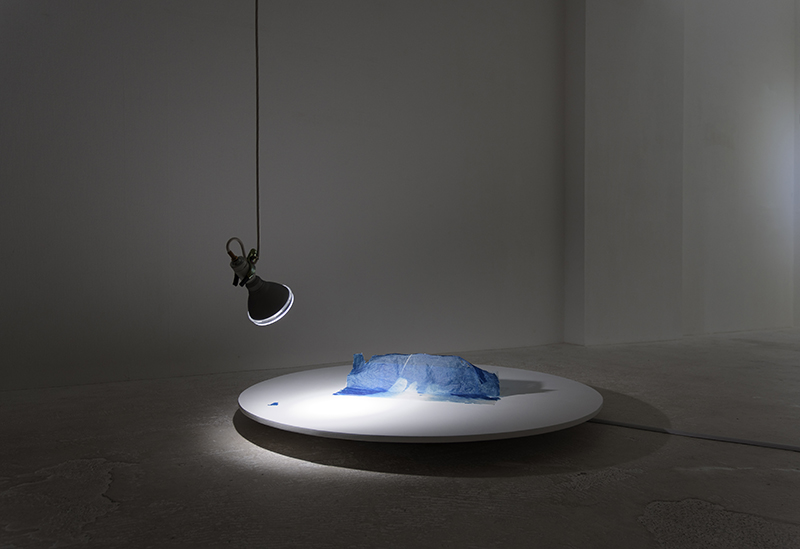Coming into contact

Coming into contact
installation view / 2017 /cyanotpye print on art tissue paper, LED light, plywood, turn table / dimention variable
as part of the curated exhibition 'unJapan'
03 November - 30 November, 2017
Kanzan Gallery, Tokyo
The exhibition 'unJapan' is curated by Philip Brophy.
The exhibitors are Taguchi Kazuna, Mori Hiroharu and Shindo Utako.
more info in Japanese

Coming into contact
detail / 2017 /cyanotpye print on art tissue paper, LED light, plywood, turn table / dimention variable

Watching Imago
installation view / 2017 / TV monitor, Video (12min 15 sec), Kamemushi(insect) /p>

Watching Imago
detail / 2017 / TV monitor, Video (12min 15 sec), Kamemushi(insect)
unJapan
text by Philip Brophy
How is a Japanese artist ‘Japanese’? How does a Japanese artist make art that is not ‘Japanese’? These two questions have haunted Japanese art since the Taisho era. For nearly a full century, Japanese art and culture has been a tidal to-and-fro, responding to either stands for isolationism or statements of internationalism. Mostly, artists push beyond Japan’s homeland borders to engage the world, only to be treated as socio-cultural diplomats for Japan’s nationhood. From Tsuguharu Foujita to Okamoto Taro to Yoko Ono to Hiroshi Sugimoto to Takashi Murakami (to name some notorious transcultural travellers in the visual arts), the cycle is perpetuated.
For sure, every ‘non-dominant’ country in the world grapples with similar questions: how do artists refute dominant imperialist frameworks and categories of artmaking? and, how do artists articulate their difference from those dominant views without caricaturing their own background and interests? Answers have been proposed at different points in time across the broad bandwidth of Japanese cultural production. Over the last half-century alone, paintings, records and movies from Japan can appear to be either desperately Western or stridently Japanese. But read closely, they also appear to be either septically Western or cryptically Japanese. Their idiomatic encoding of cultural identity is and has always been shifting and opaque. This flux in rendering identity has likely contributed to the ongoing problematic position post-war Japanese art occupies in simplistic Eurocentric tales of Modernism.
Yet this is what makes Japanese art so fascinating. Laden with self-reflexivity, unresolved criticality and obtuse strategies of expression, it rarely offers an ‘easy read’. This occurs so strongly in contemporary Japanese art, it can seem as if everything is being reversed, inverted, negated. On one hand, I always feel like I am reading Japanese art as an exotic island of Otherness (though I have no problem with the political incorrectness of such a method). On the other hand, I often feel Japanese artists are already performing this task better than I ever could. Amidst a hive of designated living treasures, national icon presentations and prefectural craft marketing, Japanese artists seem inevitably embroiled in questioning their own identity despite the resounding power bestowed on them by their cultural lineage. Under the skein of their projected imagery lies a wafer-thin transparent wall that divides their ‘internationalist’ aspirations from their ‘isolationist’ declarations.
UnJapan is a curatorial experiment, based on inviting 3 Japanese artists to openly reflect on these issues which have complexly and tacitly informed their practice for over a decade. Nothing unites these artists bar this curatorial conceit. Nor do they collectively generate a shared statement on national identity. All have lived overseas for years at a time; all have navigated transcultural waters by appearing equally to be Japanese and ‘un-Japanese’. This exhibition exploits the rudeness of my being a gaijin to ask them to openly contribute two works for this exhibition: one, addressed to fellow Japanese; the other, addressed to non-Japanese foreigners. If this sounds vulgar and pointless in its directive, it is because national identity is arguably vulgar and pointless. For despite the grand claims to debunk such nationalist strictures, one’s ‘roots’ often seem to tighten those artists most seeking to loosen their grip.
To be clear: this is a problem felt more by artists than their audience—and definitely more than their curators. Post-90s contemporary art bulges with internationalist carnivals bent on parading a heterogeneous mix of indigenous voices. While each ‘minor’ cultural representative asserts their difference to hegemonic suppositions of globalism, they are collectively ‘pre-voiced’ by the flattening perspective of curatorial strategies. Exhibitions which strive for inclusivity are often betrayed by anthropologically determined notions of indigeneity which enforce fixed ideals of cultural identity. A solo artist’s voice will always be lost in the din of this internationalist noise. UnJapan proposes that it is an artist’s choice to shape whether or not their work should perform in this way. How is a Japanese artist ‘Japanese’? By choosing to be so or not. How does a Japanese artist make art that is not ‘Japanese’? By choosing to do so or not.